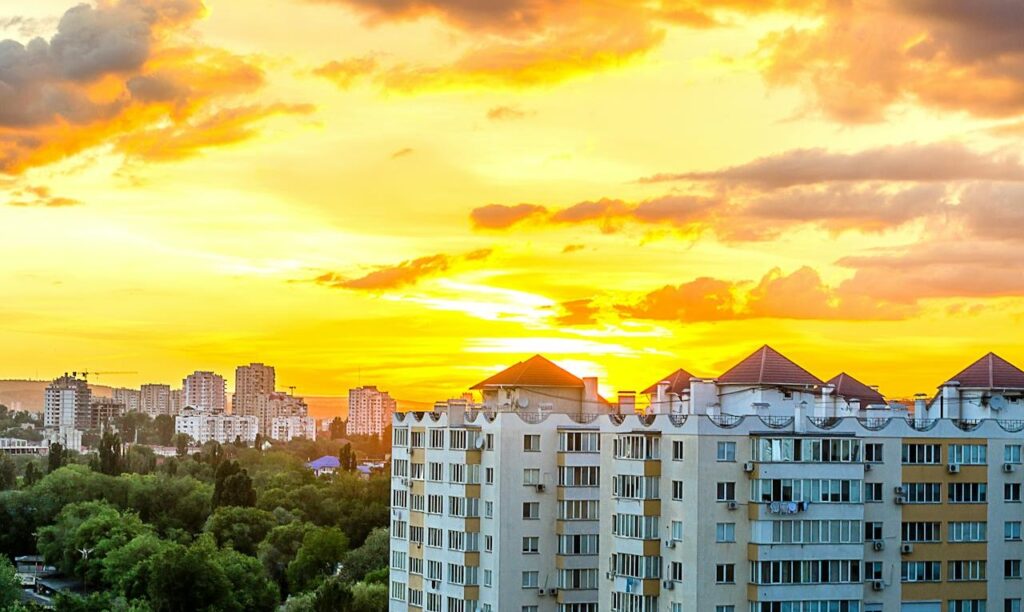Why Is the Sky Yellow: Understanding the Science Behind the Phenomenon
The color of the sky can vary from day to day and even from hour to hour. While the sky is typically blue, there are times when it may appear yellow or even orange or red. This can be a result of various atmospheric phenomena, meteorological conditions, geographical influences, chemical reactions, light reflection and refraction, and human perception.

Some of the most common reasons why the sky may appear yellow include dust, pollen, and other particles in the atmosphere, as well as pollution. Storm clouds can also cause the sky to look yellow, as they scatter the blue light coming from the sun. Additionally, sunrise and sunset can give the sky a yellow, orange, or red hue, as the light from the sun is refracted and scattered differently when it is low on the horizon.
Key Takeaways
- The color of the sky can vary due to various atmospheric phenomena, meteorological conditions, geographical influences, chemical reactions, light reflection and refraction, and human perception.
- Dust, pollen, pollution, and storm clouds are some of the most common reasons why the sky may appear yellow.
- Sunrise and sunset can also give the sky a yellow, orange, or red hue due to the way light is refracted and scattered when the sun is low on the horizon.
Atmospheric Phenomena
The yellow color of the sky can be attributed to various atmospheric phenomena. Two of the most significant ones are discussed below:
Rayleigh Scattering
Rayleigh scattering is the primary reason why the sky is blue. However, it can also cause the sky to appear yellow, especially during sunrise or sunset. During these times, the light travels a longer path through the atmosphere, which causes more scattering of shorter wavelengths. As a result, the blue color gets scattered away, and the sky appears yellow or orange.
Air Pollution
Air pollution can also cause the sky to appear yellow. When the air is polluted, tiny particles in the atmosphere scatter the light in all directions, leading to a yellowish hue. This phenomenon is especially evident in urban areas with high levels of air pollution. According to a source, an influx of dust in the atmosphere from the Sahara can also cause the sky to appear yellow.
In conclusion, the yellow color of the sky can be attributed to various atmospheric phenomena, including Rayleigh scattering and air pollution. Understanding these phenomena can help us appreciate the beauty of the sky and take steps to reduce air pollution.
Meteorological Conditions
Meteorological conditions play an important role in determining the color of the sky. The sky can turn yellow due to different reasons such as the presence of dust, pollution, or storm systems.
Storm Systems
During a storm, the sky can turn yellow due to the presence of clouds that scatter the light in a different way. The clouds can contain large amounts of water droplets or ice crystals that scatter the light, making the sky appear yellow. This can happen during the day or night, and the yellow color can be more intense during the sunset or sunrise.
Sunset or Sunrise Angles
The angle of the sun during the sunrise or sunset can also cause the sky to appear yellow. When the sun is low on the horizon, the light has to pass through more of the Earth’s atmosphere, causing the blue light to scatter and the yellow and red light to remain. This can create a yellow or orange glow in the sky.
In conclusion, the yellow color of the sky can be caused by several meteorological conditions such as storm systems or the angle of the sun during the sunrise or sunset. It is important to understand these conditions to better appreciate the beauty of the natural world.

Geographical Influences
Desert Dust
One of the reasons why the sky may appear yellow is due to an influx of dust in the atmosphere. According to Green Matters, the yellow tint in the sky is most likely due to an influx of dust from the Sahara that blew through Europe. This phenomenon is not unusual, and it happens quite regularly.
Forest Fires
Another reason why the sky may appear yellow is due to forest fires. Smoke from forest fires contains tiny particles that can scatter light and create a yellow or orange hue in the sky. According to VeryInformed, heat can also cause the sky to appear yellow. On hot summer days, the heat causes the light hue with short wavelengths to scatter fast, leaving the sky with a warm yellow shade.
It is important to note that geographical influences are not the only factors that can cause the sky to appear yellow. Other factors such as pollution, smog, and vehicular traffic can also contribute to the yellow tint in the sky.
Chemical Reactions
The yellow color of the sky can also be attributed to various chemical reactions occurring in the atmosphere. Substances such as nitrogen dioxide (NO2), sulfur dioxide (SO2), and carbon monoxide (CO) can cause the sky to appear yellow or brownish-yellow.
Industrial Emissions
Industrial emissions from factories and power plants are a significant source of these substances. When fossil fuels are burned, they release sulfur dioxide and nitrogen oxides into the atmosphere. These substances can then react with other compounds in the air to form particles that scatter sunlight and create the yellow color of the sky.
Volcanic Activity
Volcanic activity is another source of the substances that cause the sky to turn yellow. When a volcano erupts, it releases large amounts of sulfur dioxide and other gases into the atmosphere. These gases can react with water vapor and other substances in the air to form sulfuric acid and other particles that scatter sunlight and create the yellow color of the sky.
Overall, these chemical reactions can have a significant impact on the color of the sky. While natural sources such as volcanic activity contribute to this phenomenon, human activities such as industrial emissions also play a significant role.

Light Reflection and Refraction
When sunlight enters Earth’s atmosphere, it interacts with various particles, leading to the scattering of light in different directions. The scattering of light causes the blue color of the sky during the daytime. However, at sunrise or sunset, the sky appears yellow or orange due to the scattering of light at different angles.
Water Droplets
When sunlight enters the atmosphere and encounters water droplets, it undergoes refraction and reflection. The water droplets act as tiny prisms, refracting the light and splitting it into its component colors. The yellow and red colors have longer wavelengths and are less scattered than blue and violet colors, which have shorter wavelengths. Thus, during sunrise or sunset, the blue and violet colors are scattered, and the yellow and red colors pass through the atmosphere, creating a yellow or orange sky.
Ice Crystals
Ice crystals in the atmosphere can also cause the sky to appear yellow. When sunlight enters the atmosphere and interacts with ice crystals, it undergoes reflection and refraction, causing the light to split into its component colors. The yellow and red colors have longer wavelengths and are less scattered than blue and violet colors, which have shorter wavelengths. Thus, during sunrise or sunset, the blue and violet colors are scattered, and the yellow and red colors pass through the atmosphere, creating a yellow or orange sky.
In conclusion, the sky appears yellow during sunrise or sunset due to the scattering of light at different angles caused by the interaction of sunlight with water droplets or ice crystals in the atmosphere.
Human Perception
Humans perceive the color of the sky as blue, but sometimes it can appear yellow or orange during sunrise or sunset. This is due to the way light interacts with the atmosphere. However, the perception of color can vary from person to person.
Color Vision Variability
Color vision is a complex process that involves the eyes and the brain. Most people have three types of cones in their eyes that are optimized to detect different wavelengths or colors of light. However, some people may have a genetic variation that causes one type of cone to be different or absent altogether, leading to altered color vision. This condition is called color blindness and affects about 1 in 12 men and 1 in 200 women worldwide.
Optical Illusions
Optical illusions can also affect the perception of color. For example, the contrast between the color of the sky and the surrounding landscape can make the sky appear more blue or yellow. Additionally, the brain can sometimes fill in missing information to create a perception that is not entirely accurate. This is known as filling-in and can occur when there are gaps in the visual field.
In conclusion, the perception of color is a complex process that can be affected by various factors such as genetics and optical illusions. While the sky is typically perceived as blue, it can appear yellow or orange during sunrise or sunset due to the way light interacts with the atmosphere.
Frequently Asked Questions
What causes the sky to appear yellow during certain weather conditions?
The yellow appearance of the sky during certain weather conditions is due to a phenomenon called Rayleigh scattering. This occurs when sunlight passes through the Earth’s atmosphere and is scattered by air molecules. During sunrise and sunset, the angle of the sun’s rays is different, causing the light to pass through more of the atmosphere and scatter more. This results in the yellow, orange, and red hues we see in the sky.
Can atmospheric pollution lead to a yellow-colored sky?
Yes, atmospheric pollution can lead to a yellow-colored sky. When pollutants such as nitrogen oxides and sulfur dioxide are released into the air, they can react with sunlight to create a yellow or brown haze. This is known as smog and is often seen in cities with high levels of pollution.
How do tornadoes affect sky coloration?
Tornadoes can affect sky coloration by stirring up dust and debris from the ground into the atmosphere. This can cause the sky to appear yellow or even green in color. The green color is due to sunlight passing through the storm clouds and reflecting off the water droplets within them.
What does a yellow sky signify in meteorological terms?
A yellow sky can signify the presence of a storm or severe weather conditions. This is because the yellow color is often caused by the scattering of light by dust and other particles in the atmosphere, which can be associated with the approach of a storm front.
Is the yellow color of the sky at sunrise and sunset related to air quality?
No, the yellow color of the sky at sunrise and sunset is not related to air quality. It is caused by the same phenomenon of Rayleigh scattering mentioned earlier, where the angle of the sun’s rays causes the light to scatter more through the atmosphere, resulting in the yellow, orange, and red hues we see.
How does the phenomenon of Rayleigh scattering contribute to sky color changes?
The phenomenon of Rayleigh scattering contributes to sky color changes by causing sunlight to scatter differently depending on the angle and thickness of the atmosphere it passes through. This can result in different colors being visible in the sky, such as the blue color we see during the day and the yellow, orange, and red hues we see during sunrise and sunset.







